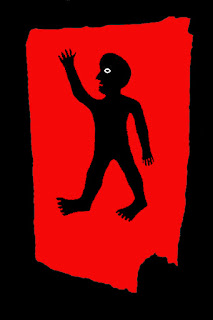Slaughter of Hauhau at Sentry Hill
Despite their magical chants and signs attacking Hauhau warriors were cut down in a hail of bullets.
When fanatical Hauhau warriors stormed the British redoubt at Sentry Hill (east of New Plymouth) on the morning of 30 April 1864 they were confident that their magical hand-signs and chants would protect them from the Pakeha bullets.
Below: Hauhau flag with figure making the upraised had (ringatu) gesture to ward off bullets.
Soldiers in the small fort watched in amazement as over 200 armed Maori marched fearlessly toward them across mostly open country, lead by chiefs including Te Whiti and Tohu Kakahi (afterwards the prophets of Parihaka). With their right hands uplifted and chanting “Hapa, hapa, hapa! Hau, hau, hau! Pai-marire, rire, rire—hau!” the warriors marched up the small hill.
Equally confident in their fire-power the 75 well-armed troops of the 57th Regiment held their nerve until the zealots came within metres. Unfortunately for the Maori their incantations and gestures were no match for a hail of hot lead.
Accounts of Maori casualties vary: from 30 to 50 dead with as many again wounded. One soldier was killed.
Amongst the wounded was one Titokowarau. A fighting chief and tohunga who paid the price of an eye for this salutory tactical lesson - one he learnt well and later used to great effect against the British in South Taranaki.
In 1920 historian and author James Cowan interviewed Te Kahu-pukoro “probably the last of the Maori warriors who attacked Sentry Hill....His father and uncle fell at Sentry Hill, and he himself received two bullet-wounds there.” Te Kahu-pukoro was 12 at the time, and went on to fight under Titokowarau in most engagements in Taranaki in the late 1860’s.
He told Cowan: “Now, had we followed the advice of our prophet Hepanaia we might had succeeded in our assault on the soldiers' fort. Hepanaia proposed that the ope should make a sudden attack on the rear of the fort, but Hare te Hokai, a chief of Te Atiawa, insisted that the force should boldly attack the place in front, and this met with the support of most of the other chiefs. Another unfortunate thing was that, as we were marching from Manutahi, one of our men discharged his gun in order to give warning to any Atiawa people who might chance to be in or near the redoubt, for some of that tribe were serving on the pakeha side. This gave the soldiers warning of our approach.”
The chant of “Hau, hau, hau!” gave the violent religious movement its name. “Hau” literally means “wind” but referred to the life principle or vital spark of man. Hauhauism began as a peaceful, revealed, religion ( Pai Marire) shortly earlier, but its supernatural appeal turned a desperate people to war.
ACCESS:
Unfortunately this historical site is long-gone - levelled for railway ballast and road metal.
Historians place Sentry Hill beside Mountain Road (on Hwy 3A just off Hwy 3 on the way South to Inglewood) - somewhere in the vicinity of the present bridge. There are several conical hillocks in the area - which look very much like the one the Sentry Hill Redoubt was situated on. However I could see nothing on the private land before me, and there was no signpost. I found a small area to park on the shoulder by the bridge while I examined my maps and the scene, but large speeding trucks passed within a metre of me: making the stop most unpleasant.
At the nearby Pistol Club I asked a shooter about Sentry Hill Redoubt. He replied that it was long gone: “...quarried completely away...there’s a small lake there now....the only time I’ve been there was in the 60’s with my brother-in-law to look at his marjiuana crop!”
Below - approximate location of the redoubt:
Further reading:
James Cowan
“THE NEW ZEALAND WARS: A HISTORY OF THE MAORI CAMPAIGNS AND THE PIONEERING PERIOD: VOLUME II: THE HAUHAU WARS, (1864–72)”
Read the Sentry Hill chapter online:
http://nzetc.victoria.ac.nz/tm/scholarly/tei-Cow02NewZ-c2.html






Comments
Post a Comment